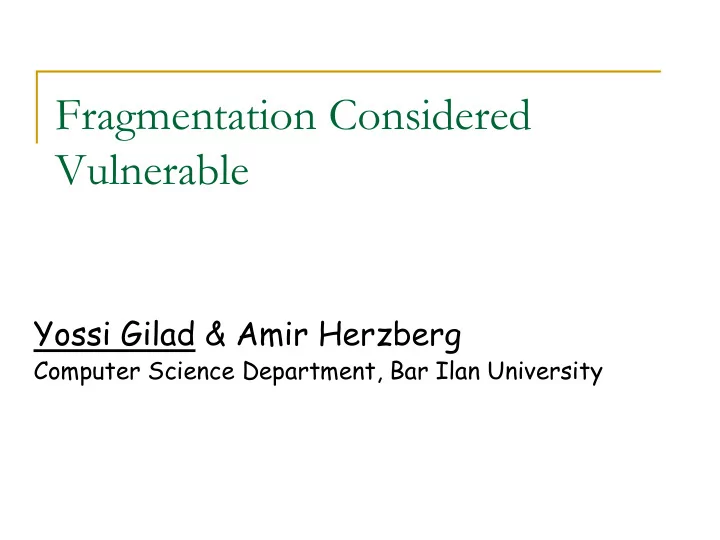

Fragmentation Considered Vulnerable Yossi Gilad & Amir Herzberg Computer Science Department, Bar Ilan University
Overview IP fragmentation recap `Easy case’ fragment miss -association attacks Fragmentation attacks in tunnels Conclusions
IP Fragmentation - Recap Today: attacks on IP fragmentation Blind (spoofing only) attacker Interception and DoS attacks. The Internet is a diverse network Different Maximal Transmission Units (MTUs) on different links/nets What if |long-pkt|>MTU? LongPkt LongPkt MTU Alice Router Router Router Defragment (fragment)
IP Fragmentation - Recap Solution 1: Path MTU discovery (PMTUd) Discard oversized pkt, inform sender (via ICMP) Requires connection Solution 2: IP fragmentation ‘Break’ long pkt into fragments (|frag|<MTU) Fragment at: any node (IPv4) / only src (IPv6) Defragment: only at destination According to: source, destination, protocol & frag ID Long Pkt Long Pkt Long Pkt LongPkt LongPkt MTU Alice Router Router Router Bob (fragment) (Defragment)
‘Fragmentation considered Harmful’ IP fragmentation is conceptually easy, but… Wasteful/harmful [KentMogul87] Complexities: may arrive late or out of order, overlap How much storage? How long keep fragments in cache? But: still often used PMTUd often fails (for UDP, no ICMP feedback,…) Fragmentation is common in UDP and tunneled traffic [Shannon02]
‘Fragmentation considered Harmful’ Implementation vulnerabilities: Memory allocation DoS attacks: TearDrop, Rose… Tiny fragment evasion of firewalls Specification vulnerabilities: Fragment cache overflow attack [KPS03] Zalewski (2003) notes that fragmented TCP traffic can be vulnerable to (blind) TCP injections Fragment mis-association attack [M04,rfc4963]
Fragment Misassociation Attack MTU= MTU= 1500B 1000B SrcIP=Alice, Dst=Bob, ID=1, Offset=980, MF=0 SrcIP=Alice, Dst=Bob, ID=2, Offset=980, MF=0 …. SrcIP=Alice, Dst=Bob, HDR+1480B ID=b, Offset=980, MF=0 (ID=x) HDR+980B, ID=x, offset=0 (if x≤b) HDR+500B, ID=x, offset=980 (stays in cache till timeout or kills next ID=x frg) Fragment mis-association attack: But, Send fake 2 nd frag with same ID… |cache|<<#frags (drop%<<1%)
What if… Frag mis-association has low drop rate What if attacker can find the `next’ ID? Trivial to `kill’ packet (DoS) Can also `inject’ a fragment Need to fix checksum Checksum can be disabled for UDP How is the IP ID chosen (by the sender)? Usually a counter – this is specifically recommended by IPv6 specification Two main approaches: Global counter (Windows) Per-destination counter (Linux)
Sometimes, ID Exposing Is Easy When the sender uses a global identifier Just by observing any packet from the sender When the attacker has a zombie behind the NAT with the destination Can also intercept fragments! Rewrite transport layer header
Sometimes, ID Exposing Is Easy Intercepting fragments SrcIP=Alice, DstIP=NAT, ID=i+1, Offset=1480, MF=0 A. Src-IP=Alice, Dst-IP=NAT, ID=i+1, Offset=0, MF=1, Dst- port: Bob’s discarded B. SrcIP=Alice, DstIP=NAT, ID=i+1, Offset=1480, MF=0 cached SrcIP=Alice, DstIP=NAT, ID=i+1, Offset=0, MF=1, Dst- port: Zombie’s, No chksum mis-associated with Alice frag. B Defrag & forward to Zombie
Fragment Interception: Results Results for IP tables based NAT 92.00% Fragment interception ratio 90.00% 1024 fragments are in 88.00% the cache 64 fragments are in the 86.00% cache 84.00% 82.00% 80.00% 0 20 40 60 80 100 Attacker's bandwidth mbit/sec
Other Cases? Can similar attacks apply when sender uses per-destination IP-IDs? Easy: if there is NAT (shown before) What if there is no NAT? Yes! For a tunnel scenario
ID Exposing Attack Alice and Bob are connected via a tunnel Main difference from NAT scenario: Packets `on the Internet’ have a different IP header Adversarial agent, PuZo, can not `see’ the `Internet’ ID Improved motivation: fragmentation is common in tunnels In talk: Zombie (to receive raw IP packet) In paper: Puppet (running in sandbox)
ID Exposing Attack Use packet loss as a side channel to identify the current ID within the tunnel We assume no benign traffic or packet loss Full version shows how to deal with those
ID Exposing Attack – Basic Version S GW B PuZo GW A Begin Get File Mis- associated
ID Exposing Attack – Basic Version S GW B PuZo GW A . . . . . . . . . . . .
ID Exposing Attack - Meet in the Middle But… if n is the number of possible identifiers, this attack requires to send O(n) packets. 2 16 for IPv4, for 2 32 IPv6 Revise with meet in the middle technique
ID Exposing Attack - Meet in the Middle Send fragments lay traps n n Narrow the search space to n Detect loss assume `ID hit’ (frag. mis -association) Exhaustive search over all remaining IDs Reduced number of packets to O( ) n Also feasible for IPv6 (n = 2 32 )
Continual Deny & Expose Mal has the current ID Goal: deny fragmented traffic Main Difficulty: maintain synchronization with current IP ID Incremented for every packet (regardless of arrival/loss)
Continual Deny & Expose Basic idea: use PuZo to `monitor’ IP ID progress Send two sequences of spoofed fragments with consecutive IDs Small `gap’ of unset IDs between them PuZo makes a periodic request for data Response arrives ID within the gap Send the next sequence
Continual Deny & Expose - Results Success depends on the number of forged fragment attacker can `cache in’ Usually 64 or no limitation (except cache size, 6500+) 100.00% 99.00% 98.00% 97.00% Loss Rate 96.00% 95.00% 94.00% Open source, 256 93.00% Open source, 64 92.00% Commercial, 256 Commercial, 64 91.00% 90.00% 0 20 40 60 80 100 Attacker's bandwidth Mbit/sec
Conclusions Fix IP ID Add appropriate defenses to network firewalls, IDS/IPS Need to improve specification of networking protocols Need to develop validation techniques Further motivation for [Gont11]
Questions?
Recommend
More recommend